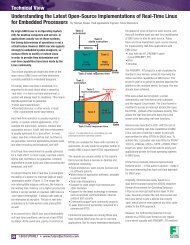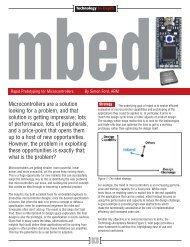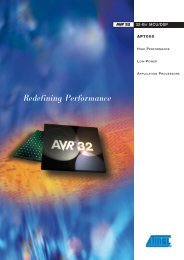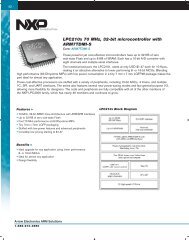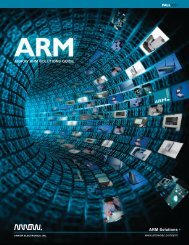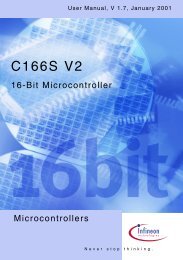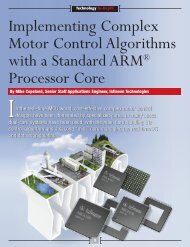ArrowARM Guide - Embedded Developer
ArrowARM Guide - Embedded Developer
ArrowARM Guide - Embedded Developer
Create successful ePaper yourself
Turn your PDF publications into a flip-book with our unique Google optimized e-Paper software.
8 |ARM7TDMI and ARM7TDMI-SARM 32-Bit RISC Core with 16-Bit System CostsThe ARM7TDMI core is the industry’s most widely used 32-bit embedded RISC microprocessor. The ARM7TDMI-S is asynthesizable version of the ARM7TDMI. Optimized for cost- and power-sensitive applications, the ARM7TDMI solutionprovides the low power consumption, small size, and high performance needed in portable, embedded applications.The ARM7TDMI core is a 32-bit embedded RISC processor delivered as a hard macrocell optimized to provide the bestcombination of performance, power, and area characteristics. The ARM7TDMI core enables system designers to buildembedded devices requiring small size, low power, and high performance.The ARM7 family also includes the ARM7TDMI processor, the ARM7TDMI-S processor, the ARM720T processor, and theARM7EJ-S processor, each of which has been developed to address different market requirements.RISC Advantages The ARM architecture is based on the Reduced Instruction SetComputer (RISC) principles. The RISC instruction set andrelated decode mechanism are much simpler than those of theComplex Instruction Set Computer (CISC) designs. Thissimplicity has the following advantages:• A high instruction throughput• An excellent real-time interrupt response• A small, cost-effective, processor macrocellThe Instruction Pipeline • The instruction pipeline• Memory access• Memory interface• <strong>Embedded</strong>ICEA R M 7 T D M I - SControllogic32-bitALUCoprocessorInterfaceETM Interface<strong>Embedded</strong>ICE-RTlogicHigh-performancemultiplierBus Interface UnitThumbdecoderThe Instruction Pipeline The ARM7TDMI core uses a pipeline to increase the speed ofthe flow of instructions to the processor. This allows severaloperations to take place simultaneously.A three-stage pipeline is used, so instructions are executed inthree stages:• Fetch (the instruction is fetched from memory)• Decode (decoding of registers used in the instruction)• Execute (register/s read from register bank; shift and ALUoperations; write register/s back to register bank)During normal operation, while one instruction is being executed,its successor is being decoded and a third instruction is beingfetched from memory.Arrow Electronics ARM Solutions1-866-910-3650Memory Access The ARM7TDMI core has a Von Neumann architecture with asingle 32-bit data bus carrying both instructions and data. Onlyload, store, and swap instructions can access data from memory.This simplifies the internal logic of the processor memory interfaceusing less die area.Memory Interface The ARM7TDMI processor memory interface has been designedto allow performance potential to be realized while minimizing theuse of memory. Speed-critical control signals are pipelined toallow system control functions to be implemented in standardlow-power logic. These control signals facilitate the exploitationof fast-burst access modes supported by many on-chip andoff-chip memory technologies.



